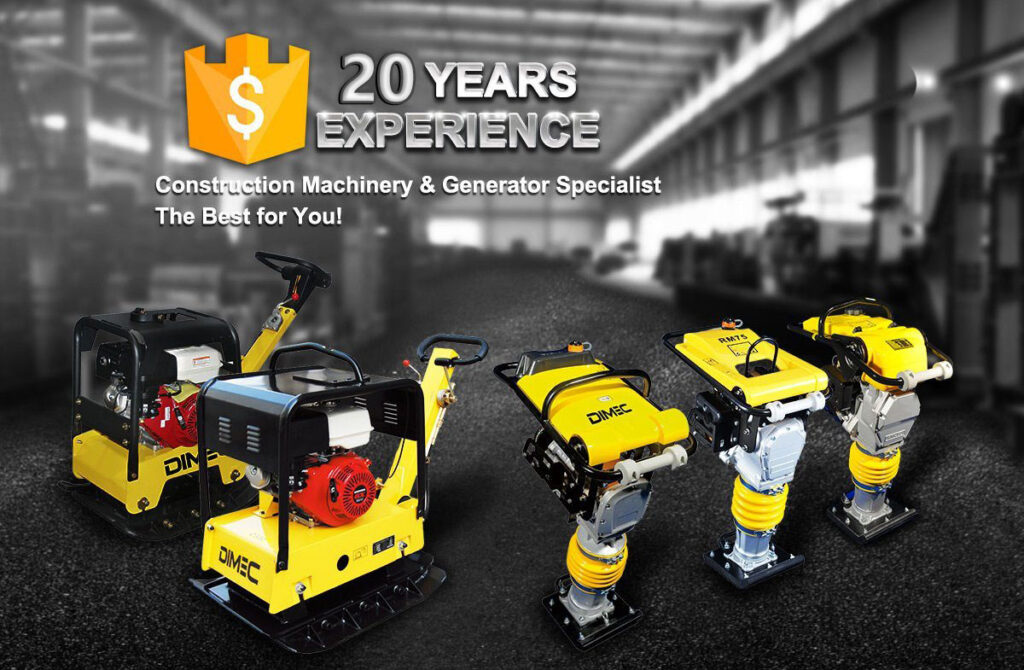How Do Vibratory Rammers Differ from Other Compaction Equipment?
- DIMEC
- Vibratory Rammer
Home » How Do Vibratory Rammers Differ from Other Compaction Equipment?

Table of Contents
Introduction
When it comes to construction and landscaping, one often overlooked but crucial aspect is soil compaction. Properly compacted soil ensures stability and durability for structures and pavements. Various types of compaction equipment are available, each suited for different tasks and soil conditions. Today, we’ll delve into the specifics of vibratory rammers(Tamping Rammer) and see how they stand out from other compaction equipment.
Understanding Compaction Equipment
Definition and Purpose
Compaction equipment is used to increase soil density by reducing air gaps, which enhances the soil’s load-bearing capacity. This process is vital for constructing stable foundations, roads, and other structures.
Types of Compaction Equipment
Compactor machines come in various forms, including vibratory rammers, plate compactors, and roller compactors. Each type has unique features and is designed for specific compaction tasks.
What Are Vibratory Rammers?
Definition and Description
A vibratory rammer is a type of compaction equipment that uses a combination of vibration and impact force to compact soil. It is typically used in confined areas where larger machines can’t reach.
Key Features of Vibratory Rammers
- High Impact Force: Delivers powerful blows to the soil.
- Mobility: Lightweight and easy to maneuver.
- Versatility: Suitable for a variety of soil types and conditions.
Types of Vibratory Rammers
Manual Rammers
These are operated by hand, making them ideal for small-scale tasks and tight spaces.
Mechanical Rammers
Powered by engines, mechanical rammers offer more power and efficiency, suitable for larger projects.
Advantages of Using Vibratory Rammers
High Compaction Efficiency
Vibratory rammers provide excellent compaction results, ensuring a stable base for construction.
Ease of Use and Mobility
Their compact size and lightweight design make them easy to transport and operate, even in confined spaces.
Durability and Longevity
Built to withstand harsh conditions, vibratory rammers are durable and require minimal maintenance.
Applications of Vibratory Rammers
Construction Sites
Ideal for compacting soil in trenches, around foundations, and in other confined areas.
Road Maintenance
Used for repairing potholes and compacting asphalt in small patches.
Landscaping Projects
Perfect for preparing garden beds and walkways, ensuring a solid foundation for various landscaping elements.
Comparison with Other Compaction Equipment
Plate Compactors
Definition and Usage
Vibratory plate compactors use a large vibrating plate to compress soil and asphalt, suitable for larger, flat surfaces.
Pros and Cons
- Pros: Efficient for large areas, relatively easy to operate.
- Cons: Limited effectiveness in confined spaces, less impact force compared to rammers.
Roller Compactors
Definition and Usage
Roller compactors use large, heavy drums to roll over and compress soil. They are ideal for extensive areas like roadways and large foundations.
Pros and Cons
- Pros: High efficiency for large projects, excellent compaction depth.
- Cons: Bulky, not suitable for confined spaces, higher operational costs.
Vibratory Rammers vs. Plate Compactors
Performance Comparison
Vibratory rammers excel in confined spaces and for tasks requiring high impact force, while plate compactors are better for flat, open areas.
Situational Advantages
Use vibratory rammers for trenches and small patches, and plate compactors for larger, open areas.
Vibratory Rammers vs. Roller Compactors
Performance Comparison
Rammers provide better maneuverability and are suitable for small-scale projects, whereas rollers are designed for extensive areas and deeper compaction.
Situational Advantages
Choose vibratory rammers for tight spaces and detail work, and roller compactors for large-scale projects like road construction.
Choosing the Right Compaction Equipment
Factors to Consider
- Project Size: Larger projects may require roller compactors.
- Soil Type: Some equipment is better suited for certain soil conditions.
- Space Constraints: Confined areas may necessitate the use of vibratory rammers.
Project-Specific Requirements
Evaluate the specific needs of your project to determine the most appropriate compaction equipment.
Innovations in Compaction Equipment
Technological Advancements
Recent innovations include automated and remote-controlled compaction equipment, increasing efficiency and safety.
Future Trends
The future of compaction equipment may see more environmentally friendly options and advanced technologies for improved performance.
Maintenance Tips for Vibratory Rammers
Regular Inspection
Frequent checks for wear and tear can prevent breakdowns and extend the life of the equipment.
Proper Storage
Store rammers in a dry, sheltered location to protect them from the elements.
Common Issues and Troubleshooting
Be aware of common problems like engine issues and improper compaction, and know how to address them.
Safety Considerations
Safe Operating Practices
Always follow the manufacturer’s guidelines and use the equipment as intended to avoid accidents.
Personal Protective Equipment (PPE)
Operators should wear appropriate PPE, including gloves, safety glasses, and ear protection.
Conclusion
Vibratory rammers are a versatile and essential tool in the compaction equipment arsenal. They stand out for their high impact force, mobility, and suitability for confined spaces. While other compaction equipment like plate and roller compactors have their own advantages, the vibratory rammer excels in situations requiring precise and powerful compaction. Choosing the right equipment depends on the specific needs of your project, and staying informed about advancements in technology can further enhance your compaction results.
FAQs
What is the primary purpose of a vibratory rammer?
The primary purpose of a vibratory rammer is to compact soil in confined areas, ensuring a stable base for construction projects.
Can vibratory rammers be used on all soil types?
Yes, vibratory rammers are versatile and can be used on various soil types, including cohesive and granular soils.
How often should vibratory rammers be maintained?
Regular maintenance, including inspections and servicing, should be performed based on the manufacturer’s recommendations, typically after a set number of operational hours.
What are the common issues faced when using vibratory rammers?
Common issues include engine problems, improper compaction, and wear and tear on parts. Regular maintenance can help mitigate these problems.
Are there environmentally friendly options for compaction equipment?
Yes, advancements in technology are leading to more environmentally friendly compaction equipment, including electric and hybrid models that reduce emissions.
You May Also Like